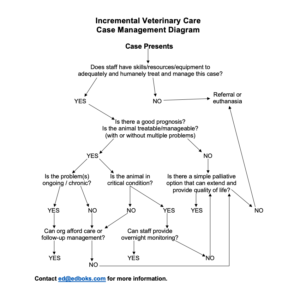Understanding Incremental Veterinary Care in the Shelter Environment
At its core, incremental veterinary care is a case management strategy that empowers shelter veterinarians to make informed decisions about the allocation of limited resources based on the individual needs of each patient and the overall welfare of the shelter population. This approach acknowledges the inherent financial constraints of shelters while prioritizing the well-being of the animals under their care.
Tiered Diagnostic Approach
Incremental veterinary care unfolds as a tiered diagnostic approach, where therapeutic options are tailored to the shelter’s capacity, including staff expertise, available space, equipment, and budget. This approach minimizes unnecessary diagnostic procedures and focuses resources on interventions that offer the greatest benefit to both the individual animal and the shelter population as a whole. By leveraging the clinical judgment and experience of shelter veterinarians, incremental veterinary care maximizes efficiency and effectiveness in the face of limited resources.
Active Follow-Up and Collaboration
Central to the success of incremental veterinary care is active follow-up and collaboration between shelter staff and the veterinary team. Shelter staff serve as the primary caregivers for the animals, actively participating in their medical care and closely monitoring their clinical progress. Effective communication and collaboration between shelter staff and veterinarians are essential for ensuring timely and accurate care decisions and optimizing patient outcomes.
Strategic Decision-Making
When navigating significant financial limitations, shelter veterinarians employ a series of objective evaluations to guide their decision-making process. These evaluations assess factors such as the shelter’s capacity to treat and manage the case, the prognosis and treatability of the condition, the availability of follow-up care and resources, and the overall condition of the animal. By asking critical questions and evaluating prognostic indicators, shelter veterinarians can develop tailored treatment plans that maximize the chances of a positive outcome for each patient. (See diagram below)
Integration into Population Health Management
Beyond individual case management, incremental veterinary care extends to prevention, early diagnosis, and intervention for the entire shelter population. By implementing proactive health strategies and targeted interventions, shelters can mitigate the risk of disease outbreaks, address emerging health concerns, and optimize the overall health and well-being of shelter animals. This population-based approach complements individual case management efforts and contributes to the overall success of medical rehabilitation programs within animal shelters.
Conclusion: Empowering Compassionate Care Within Constraints
In conclusion, incremental veterinary care exemplifies a compassionate and pragmatic approach to medical rehabilitation within animal shelters, offering a pathway to healing and hope within the confines of limited resources. By prioritizing patient-centered care, leveraging clinical expertise, and fostering collaboration between shelter staff and veterinarians, incremental veterinary care ensures that every animal receives the support they need to thrive. In a landscape defined by challenges and constraints, incremental veterinary care stands as a testament to the resilience and dedication of those committed to the well-being of shelter animals.
